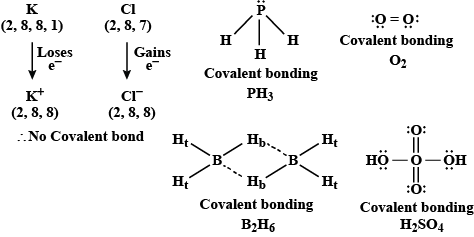
Which of the following compounds contains no covalent bonds? $KCl$ , $P{H_3}$ , ${O_2}$ , ${B_2}{H_6}$ , ${H_2}S{O_4}$
(A) $KCl$
(B) $KCl$ , ${B_2}{H_6}$
(C) $KCl$ , ${B_2}{H_6}$ , $P{H_3}$
(D) $KCl$ , ${H_2}S{O_4}$
Answer
565.8k+ views
Hint: In this, we are discussing the covalent bonds (the bond exists between two atoms and shared electrons mutually) and also identify the compounds which do not possess covalent bonds.
Complete step by step answer:
A Covalent bond, also called a molecular bond, is a chemical bond that involves the sharing of electron pairs between atoms . These electron pairs are known as shared pairs or bonding pairs, and the stable balance of attractive and repulsive force between atoms, when they share electrons , is known as covalent bonding.
For example : $P{H_3}$ , ${O_2}$ , ${B_2}{H_6}$ , ${H_2}S{O_4}$
Formation of Covalent Bond:

As you can see in the above diagram that all the molecules have covalent bonds except $KCl$ which is bonded by ionic bonding since it contains potassium and chloride .
Formation of covalent bonds takes place when the difference between the electronegativity of the two atoms involved in the bond formation is very less . Basically sharing of electrons takes place in covalent bonds . Shared electrons located in the space between the two nuclei are called bonding electrons.
Types of Covalent Bond: Single Bond, Double Bond and Triple Bond.
According to the question,
The option (A) is the correct answer. Because $KCl$ is Ionic bond (A bond between two atoms in which electrons can be completely transferred) not covalent bond and other compounds show covalent character.
So, the correct answer is Option A.
Note:
Covalent compounds may exist as solid , liquid or gas at room temperature and at normal atmospheric pressure . They do not conduct electricity either in pure form or in aqueous solution . Their melting point and boiling points are also low .
Complete step by step answer:
A Covalent bond, also called a molecular bond, is a chemical bond that involves the sharing of electron pairs between atoms . These electron pairs are known as shared pairs or bonding pairs, and the stable balance of attractive and repulsive force between atoms, when they share electrons , is known as covalent bonding.
For example : $P{H_3}$ , ${O_2}$ , ${B_2}{H_6}$ , ${H_2}S{O_4}$
Formation of Covalent Bond:

As you can see in the above diagram that all the molecules have covalent bonds except $KCl$ which is bonded by ionic bonding since it contains potassium and chloride .
Formation of covalent bonds takes place when the difference between the electronegativity of the two atoms involved in the bond formation is very less . Basically sharing of electrons takes place in covalent bonds . Shared electrons located in the space between the two nuclei are called bonding electrons.
Types of Covalent Bond: Single Bond, Double Bond and Triple Bond.
According to the question,
The option (A) is the correct answer. Because $KCl$ is Ionic bond (A bond between two atoms in which electrons can be completely transferred) not covalent bond and other compounds show covalent character.
So, the correct answer is Option A.
Note:
Covalent compounds may exist as solid , liquid or gas at room temperature and at normal atmospheric pressure . They do not conduct electricity either in pure form or in aqueous solution . Their melting point and boiling points are also low .
Recently Updated Pages
Why are manures considered better than fertilizers class 11 biology CBSE

Find the coordinates of the midpoint of the line segment class 11 maths CBSE

Distinguish between static friction limiting friction class 11 physics CBSE

The Chairman of the constituent Assembly was A Jawaharlal class 11 social science CBSE

The first National Commission on Labour NCL submitted class 11 social science CBSE

Number of all subshell of n + l 7 is A 4 B 5 C 6 D class 11 chemistry CBSE

Trending doubts
Differentiate between an exothermic and an endothermic class 11 chemistry CBSE

10 examples of friction in our daily life

One Metric ton is equal to kg A 10000 B 1000 C 100 class 11 physics CBSE

Difference Between Prokaryotic Cells and Eukaryotic Cells

1 Quintal is equal to a 110 kg b 10 kg c 100kg d 1000 class 11 physics CBSE

State the laws of reflection of light




